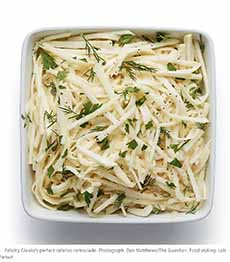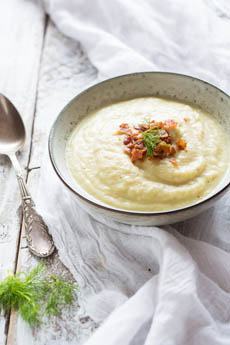Celeriac (a.k.a. Celery Root) & A Celeriac Remoulade Recipe
|
EDITOR’S NOTE: The producer of the cooking video has withdrawn it from circulation, so we have provided this link to another celeriac rémoulade recipe. Celeriac (Apium graveolens), a large, gnarled globe of a root vegetable, is one of the less attractive items in the produce section. Most people would pass it by without investigation. But peel away the skin and you’ll discover creamy flesh like a parsnip’s—to which it is related. Its botanical family, Apiaceae—commonly known as the carrot or parsley family—includes numerous* well-known vegetables. *Some other cousins include angelica, anise, caraway, celery, chervil, coriander/cilantro, cumin, dill, fennel, lovage and sea holly. Celeriac developed from the same wild plant as our familiar long-stalk green celery, but you’d never know from looking at them that they are kin. Over the millennia, different strains of original plants were developed for different reasons, some focusing on the root, others on the stems or leaves. A Vegetable Of Several Names Called céleri in French and celeriac in English, the vegetable is also called celery root, knob celery, and turnip-rooted celery. It can be eaten raw or cooked. We first discovered celeriac as a child, ordering from a menu at a French restaurant. We didn’t know French at the time, which made food choices difficult. But céleri rémoulade sounded like celery, a vegetable we enjoyed. We were instantly converted, and still order the dish every time we find it on a menu. While there are many wonderful ways to prepare celeriac (check beneath the video), with this recipe we introduce you to our childhood favorite, a classic French appetizer salad. The raw celeriac knob is peeled and cut into matchsticks and dressed with a Dijon mustard-accented homemade mayonnaise called rémoulade sauce. It is delicious as a first course in a lettuce cup or atop greens, or as a side with anything you might serve with coleslaw, including charcuterie. There are many wonderful ways to prepare celeriac—from soups, stews and purées to fish and seafood dishes. Search out recipes for: Native to the Mediterranean Basin, celeriac grows both wild and cultivated around the world. It was used in ancient civilizations—Egypt, Greece, and Rome—and is mentioned (called selinon) in Homer’s Odyssey, composed circa 800 B.C.E. (the exact dates of Homer’s birth and death are unknown). But in ancient times, celeriac was used largely for medical and religious purposes. It did not become an important food crop until the Middle Ages. The first mention of celeriac as a food plant comes from 17th century France (1623). It was commonly cultivated in most of Europe by the end of the century. Celeriac has just 40 calories per cup, and zero fat or sugar. Find more of our favorite vegetables. Rémoulade is a variation of mayonnaise sauce, one of the five mother sauces of French cuisine (along with sauce espagnole, tomato sauce, béchamel, velouté, and hollandaise, which is the fraternal twin of mayonnaise). According to EtymOnline.com, the term rémoulade is derived from remolat, a dialect word for horseradish, the botanical name of which is Armoracia rusticana. There may have been horseradish in earlier European recipes; horseradish is used in Louisiana-style rémoulade. |
|
|
|
Rémoulade is similar to tartar sauce; but in the céleri rémoulade recipe, only parsley and perhaps a touch of garlic is used to flavor it. Larousse Gastronomique shows that the full rémoulade sauce recipe—used to dress fish, seafood and other dishes—also includes chervil, chives, tarragon, capers, diced cornichons and anchovy sauce (a favorite condiment of the Romans, called garum). Once you see how easy it is to make homemade mayonnaise—just whisk together egg yolks, lemon juice, and vegetable oil—and how much better it tastes, you may find a new kitchen favorite. Many recipes will tell you to serve the céleri rémoulade immediately. That’s because the cut celeriac will start to turn brown when it is exposed to air. While the rémoulade dressing is a protective coating, the celeriac will ultimately turn brown after a few days in the fridge—but it will still taste great. The flavor even improves as the ingredients meld over time.
|
||



